|
Newingreen
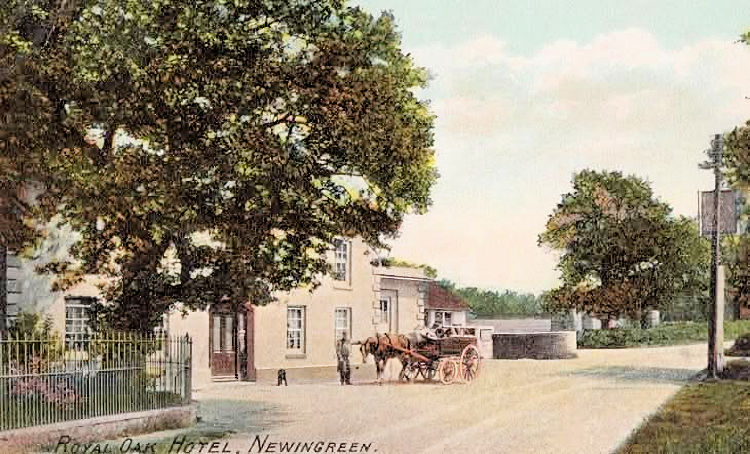
Above postcard, date unknown. |

The Royal Oak, Newingreen, date unknown. |

Above postcard, date unknown. |
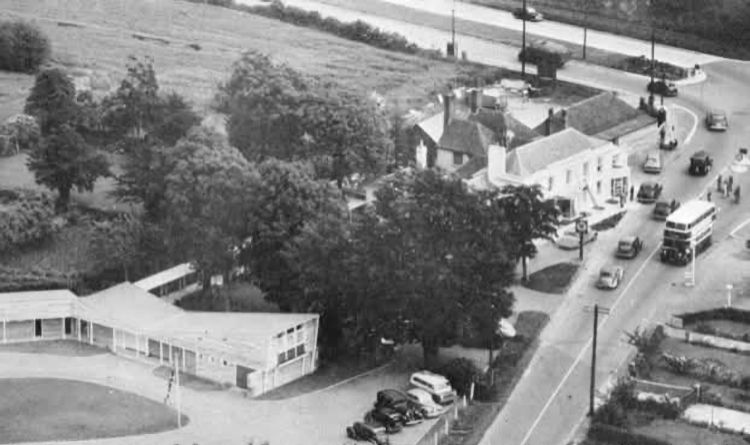
Above photo 1955. |
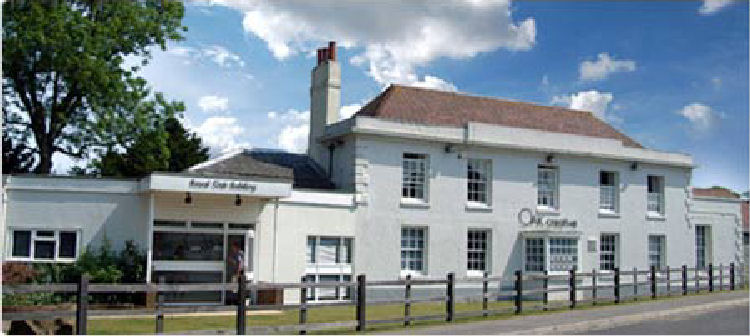
Above photo of the closed Royal Oak, circa 2009.
|

Above Google image, August 2016. |
|
Awaiting picture of Whitbread sign.
Above card issued March 1955. Sign series 4 number 36. |
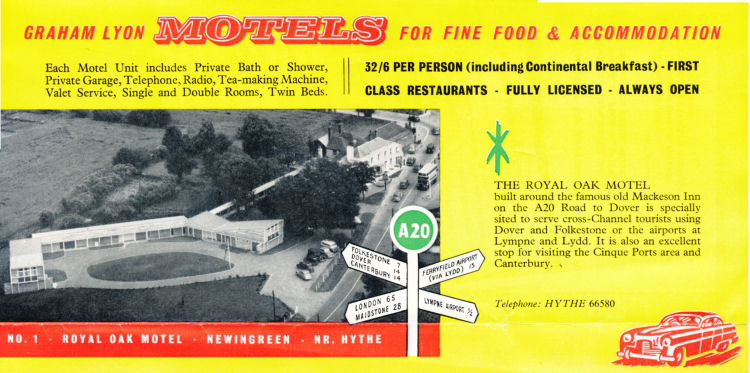
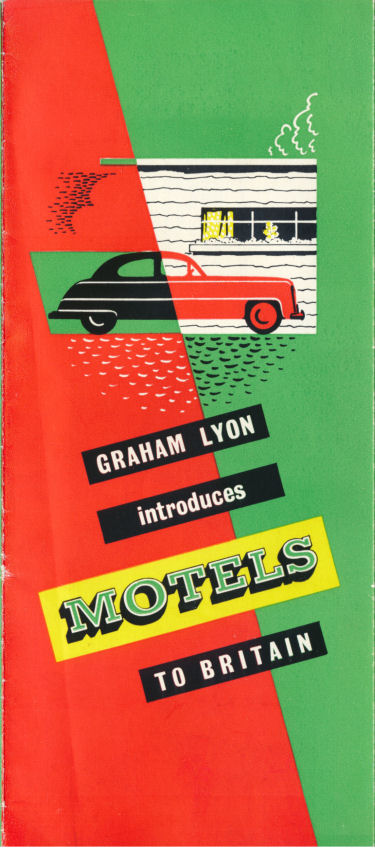 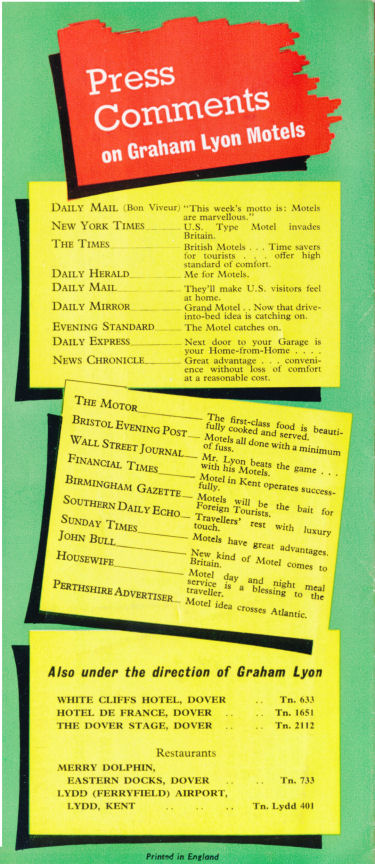

Above pictures kindly sent by Sjef van Eijk from the Netherlands and
was taken from a 1950s leaflet advertising the Graham Lyon motels. |
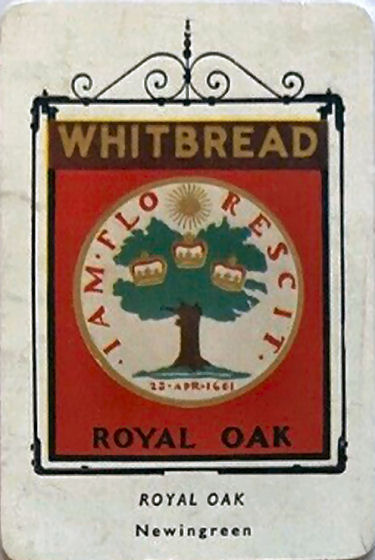
Above Whitbread card, 1973 and series unknown. |
|
|
Originally one of the tied houses to Mackeson, now unfortunately closed
and at one time Motel and restaurant, just off Stone Street who back looks
over the Folkestone racecourse. The building is
now the home of Oak Creative, a web design company.
This inn known by the name and sign of The Royal Oak was built in the 2nd
year of Elizabeth I, in 1560. Though much of this original structure having
been altered and modified during the reign of George III, is now engulfed in
the present day building.
When first built the property was a farm dwelling and drovers cottage,
owned by the estate of one Thomas Finch of Canterbury, who possessed lands
and properties in that city, and the parishes of Stanford, Lympne, Hythe and
Waltham. He possessed of this property as part of his estate with a farmer
in occupation until his death in 1587, whereupon by the terms of his will,
his estate passed to his son William, who possessed of the estate until his
death in 1618, where after the property and his estate passed to his son
Thomas. He, in the year 1627 disposed of certain parts of his fathers
estate, including this property to one Richard Flynn of Hythe.
In the year 1630, there resided here, bound to the estate of Flynn, one
Jeremiah Swyffte, shepherd and drover of Stanford, who resided here with his
wife Eliza and six children between 1630 and 1647. Following this period
there lived here one Edgar Datchett, farmer and grazier with his wife Mary
and Four sons until 1653. In 1672, there resided here one Thomas Wyffen,
farmer and drover and his family. By this date Richard Flynn, had died and
the property with the residue of his estate had passed to his children
Robert and Elinor, in whose descendents it continued down until at length it
came into the possession by marriage of Geoffrey Symons esq. of Hythe, in
1708.
In 1715, Geoffrey Symons sold off part of the estate, including this
house and its land, which then totalled 12 acres, to one Philip Marsh of
Stanford. In that same year Marsh disposed of eight acres of land belonging
to the house to Reuben Black, yeoman of Stanford, and in 1721, he sold the
house and its land with two cottages at Newingreen and three at Hythe to one
Amos Farley, yeoman of Hythe. He in 1730 transferred the deeds to his
property and others to one Michael Dormans, a nephew by his sisters
marriage, who possessed it until his death in 1761, where after it passed to
his son, also Michael. He in 1775 sold this house to one Caleb Buss, a
farmer and brewer of Hythe.
In 1776, Buss was granted a licence to sell ales and ciders from the
premises on certain days and between certain hours. The ale that buss sold
was probably his own home brewed beverage. The house at this date remained
an untitled beer house with Buss registered as its keeper, or beer seller or
tapster. He died in 1789, whereupon his wife Anne was granted the licence.
She ran the house until her death in 1797, whereupon her son Thomas took
over the house, and upon doing so, applied for a wine licence which he was
granted in August of that year. He then registered the house under the title
of the “Royal Oak” the origin of which dates back to the reign of Charles
II, and the restoration of the crown, and his escape from the
parliamentarians by hiding in an Oak Tree.
Thomas Buss died in 1823, whereupon the executors of his will sold the
inn to the Hythe Brewery. In that same year William Rigden took over the
licence of the Inn. He stayed until 1838 when one Thomas Barley took over,
who upon his death in 1845, was succeeded by his wife Martha, who remained
here until her death in 1866, when in that year one John Casey took over the
house. In 1873, one Thomas Divers came here to keep the Inn. During the
whole of the period he was here, until his death in 1902, he carried on his
original trade of a coal merchant as well as running the inn. Upon his death
his wife Jane took over the house, she left in 1908 and was replaced by
William Tunbridge, and in 1918 by Edward John Carrington Russell, and in
1922, by Ernest H. Cox, hereby Herbert E. Tree in 1929 and in 1936 one
Edward Robert Auckland held the licence and continued to do so for the
duration of the war years.
|
Kent Gazette Reports 3 September 1805.
To be SOLD by AUCTION, AT the "Royal Oak," at Newing Green, near
Hythe in Kent, on Friday, the 6th day of September, 1805, at three
o'clock in the afternoon, All that Messuage or Tenement, with the
barn stable, lodge and out-buildings, together with several pieces
of arable, meadows, and pasture land to the same belonging,
containing by estimation 55 acres, more or less, situate lying and
being in the parish of Stanford, with the right of common on Gyminge
Brook, now in the occupation of Mr. John Bridger.
Possession may be had at Michaelmas next.
The estate is conveniently situated about 3 miles from Hythe and 9
from Ashford, and is particularly adapted for a person using
marshland, being kindly for seeds and turnips.
For farther particulars apply to Mr. Reynolds, attorney Folkestone.
|
|
Kentish Gazette, 30 April 1844.
TO INN-KEEFERS.
TO BE LET, with Immediate Possession, THE "ROYAL OAK inn," Newing Green,
near HYTHE with capital Stabling and Coach-house,
and 4 1/2 Acres of very productive PASTURE LAND.
The House is in an excellent situation for business, on the road between
Ashford and Hythe, only two miles from Hythe, and a
quarter of a mile from the Westenhanger and Hythe Station of the South
Eastern Railway. Omnibuses call at the house every train
to convey passengers to and from the Railway Station.
Apply to Mr. Fred. Neame, Hothe Court, Blean, near Canterbury.
29th April, 1844.
|
|
From the Kentish Gazette, 28 March 1848.
Morley.
March 24, in his 28th year, Mr. George Morley, landlord of the "Royal
Oak Inn," at Newingreen, Sandford,
near Hythe.
|
|
South Eastern Gazette, Tuesday 8 March 1859.
Accident.
A few nights since, as Mr. Richards, late of the "Drum Inn," Stanford,
Mr. Roalfe, miller, Stanford, and Mr. Dyason, of the "Royal Oak Inn,"
Newingreen, were proceeding home in a fly from a concert at Sandgate,
the fly came in violent collisions with the corner of the barracks, at
the west end. Both of the hind wheels were broken from the vehicle,
which was also otherwise damaged. The occupants were very much shaken by
the fall, and one was with great difficulty extricated from his
uncomfortable position, but fortunately no serious consequences ensued.
|
|
From the Canterbury Journal, Kentish Times and Farmers' Gazette, 12 July 1884.
PETHAM. ALLEGED THEFT.
On Thursday James Smith, a labouring man, was arrested at Petham by
Police-constable Bevan on a charge of stealing a German silver watch and
imitation gold chain, the property of George Velvick. It appeared that
the watch and chain were stolen from the harness room at the "Royal Oak
Inn" Newingreen. Prisoner had been handed over to Superintendent Maxted,
and will be dealt with by the magistrates of the Elham Division.
|
|
From the Kenilworth Weekly News 5 August 1955, kindly sent by Robin D Leach.
MOTEL FITS LOCAL SETTING.
How the American motel fits admirably into an English setting is seen
at the Kenilworth Auto Villas, opened a few years ago, comments the Road
Campaign Council, a national organisation dedicated to the improvement
of road and attendant facilities.
Of the Motel, better known I locally as Rouncil Towers, the Council
adds: "Here, at the heart of England, the up-to-date motel chalets stand
in the grounds of a large Victorian mansion which contains a modem
restaurant, cocktail bar, lounge and television viewing room. All the
facilities of the house are included in the fixed nightly accommodation
charge."
The Council continues: "There is no doubt that motels are here to
stay and have a great future in serving the dollar-earning tourist
industry of this country. At present there are about half a dozen
operating in the South of England, the Midlands, Yorkshire and Scotland.
Many others are planned.
UNIVERSAL ADVANTAGES
"For the touring motorist and business man alike, the motel offers
very real advantages over the ordinary hotel. You can arrive or leave at
any hour of the day or night, and snacks or full meals are available all
round the clock. You sleep in a comfortable chalet with up-to-date
amenities, parking your car in an adjoining lock-up garage to which
there is direct access from the bedroom.
"The motel idea began in a humble way in America in the early
nineteen-thirties. The first were no more than wooden shacks, styled
'tourist cabins.' which were attached to wayside filling stations. They
provided a minimum of comfort with a bed, chair and portable oil or
spirit stove for coking food.
"American motels have developed a long way since those days. They
vary a good deal in size, but the service for motorists is generally
excellent. Many are of the luxury type with dance halls, swimming pools
and sometimes private bathing beaches attached.
BRITISH PIONEER
"But practically all the motels of the States are situated on the
great trunk road to serve the needs of long-distance travellers. Indeed,
the motel and motor road are complementary to each other and have both
grown up together in America.
"Graham Lyon, a British hotel-keeper who is a leading pioneer of
motels in this country, sees no limit to their development here if we
can get new roads built to put them on. But at present it's not easy to
find suitable sites.
"Just after the war, so many American visitors remarked on the lack
of Motels in England that Lyon felt something should be done about it.
Determined to learn all he could about the subject at first hand he made
a long tour through the United States, motoring some 15,000 miles and
visiting about 2,000 motels of all sorts.
"As a result of that trip, Graham Lyon look over a village inn on the
London-Folkestone road at Newingreen, within a few miles of the Channel
ports. Here he designed a motel incorporating the best American
features, yet with a distinctly English atmosphere. The old coaching inn
was modernised within to provide first-class catering facilities.
|
LICENSEE LIST
BUSS Thomas 1776-1823
RIGDEN William 1823-38
BARLEY Thomas 1838-45
BARLEY Martha 1845-66
MORLEY Martha 1847+

MORLEY George to Mar/1848 dec'd
DYASON John 1858-59+
CASEY John 1866-73
DIVERS Thomas 1873-1902+
 (also
coal-merchant) (also
coal-merchant)
DIVERS Jane Mrs 1902-08

TUNBRIDGE William 1908-18
RUSSELL Edward John Currington 1911-22 (age 48 in 1911 ) )
COX Edward 1922-29
TREE Herbert E 1929-34
AUCKLAND Robert Edward 1934-45+

 LYON George Ernest Graham
LYON George Ernest Graham
 1955-57
1955-57
 From
Bagshaw Directory 1847 From
Bagshaw Directory 1847
 From
the Kelly's Directory 1899 From
the Kelly's Directory 1899
 From the Kelly's Directory 1903 From the Kelly's Directory 1903
 From
the Kelly's Directory 1934 From
the Kelly's Directory 1934
 Census Census
|










